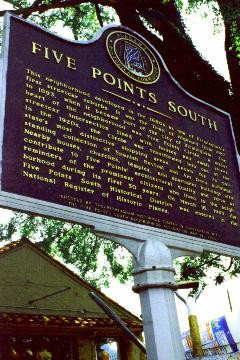
Home
About
Calendar
Yahoo Group
City Codes
Historic Homes
Garden Committee
Latest Happenings
Neighbors
Petite Southside
Maps & Districts
Good Neighbors
Block Watch
Neighborhood Assoc
Contacts
Volunteers

Vulcan's Own Neighborhood Enters It's Second Century
This article on 5 Points South was written by two knowledgeable residents of our neighborhood, Jim and Liz Reed.
The neighborhood chosen by Vulcan, the world's largest free-standing cast-iron statue, is full of surprises and small pleasures.
Five Points South, the hub of Birmingham, Alabama's southern section, came into being near the end of the 19th Century, rose and fell and rose again during the 20th Century, and now, along with the resurrection of Vulcan, our neighborhood begins the 21st Century with renewed vigor.
Five Points South's diversity is what attracts many people to Birmingham. From a quiet urban neighborhood with streetcars and horse-and-buggy travelers, the area soon became THE place to live, for those who love being near a big city. Now, Five Points South has become a delightful melting pot of ethnicities, generations, merchants, private home owners, condo dwellers, renters, well-to-do's and middle-class folks--most of whom seem to get along with one another just fine.
There's nothing cookie-cutter about the Five Points South neighborhood. Architecture ranges from Carpenter Gothic to Craftsman bungalows, mansions to cottages, high-rises to modest woodframe homes--and even a castle! But if you look closely you'll see signs that Anderson Place has many houses of the same basic design. In essence, the "model home" concept of the fifties actually started much earlier. 1400, 1406, and 1410 17th Street all have the same floor plan, just the porches have been changed to protect the look of the neighborhood. Around the corner on 15th Avenue, is another of the "models" and up 15th Street is yet another.
An excellent reference to
read (at the Library or at Reed Books' Museum of Fond Memories) is TOWN
WITHIN A CITY: THE FIVE POINTS SOUTH NEIGHBORHOOD 1880-1930 by Ann M.
Burkhardt and Alice M. Bowsher. Especially informative are Gary Dobbs'
contributions describing the character of the neighborhood.